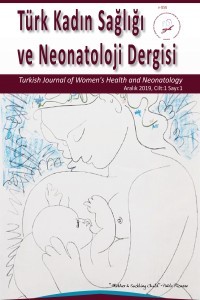İkinci Trimester Nukal Fold Kalınlık Artışı Saptanan Gebeliklerin Sonuçları
Amaç: İkinci trimesterde nukal fold (NF) kalınlık artışı saptanan fetüslerin antenatal ve doğum sonrası sonuçlarını ortaya çıkartmak.
Gereç ve Yöntem: Ocak 2014- Ocak 2021 yılları arasında ayrıntılı ultrasonografi için başvuran gebelerden NF kalınlığı saptanan 45 gebe çalışmaya alındı. NF kalınlık artışı saptanan tüm gebelere amniyosentez (A/S) önerildi. A/S’yi kabul etmeyen gebelerin bebeklerinde doğum sonrası anormal bulgu saptanması durumunda genetik test istendi. Ayrıca NF kalınlık artışı saptanan gebelere fetal ekokardiyografi dahil olmak üzere ayrıntılı ultrasonografi yapıldı. Antenatal ve doğum sonrası eşlik eden yüz anomalileri, kardiyovasküler, kraniyal, gastrointestinal, genitoüriner ve iskelet sistemi patolojiler kaydedildi.
Bulgular: NF kalınlık artışı saptanan 45 hastadan 13’ üne antenatal genetik test (9 A/S, 4 koriyon villus örneklenmesi (CVS)) yapıldı. Üç hastada antenatal, üç hastada postnatal olmak üzere 6 (%13,3) hastada genetik anormallik saptandı. Bu fetüslerden %6,6’sında Trizomi 21 (n:3, biri mozaizm), %2,2’sinde (n:1) ring 18 kromozom saptandı. Ayrıca bir Noonan Sendromu ve bir Genito-pateller Sendromlu hastaya postnatal tanı konuldu.
Fetüslerden %28’ sinde izole NF kalınlığı saptandı. Bu fetüslerde kromozomal ve yapısal anomali saptanmadı. Gebelerin %30’unda (14/45) kardiyovasküler sistem anomalisi, %20’ sinde (9/45) yüz anomalisi, %18’inde (8/45) genitoüriner sistem, %13’inde (6/45) kraniyal, %11’inde (5/45) ekstremite anomalisi saptandı.
Sonuç: Nukal fold kalınlık artışı saptanan gebelere ayrıntılı ultrasonografı yapılmalı ve genetik inceleme önerilmelidir. Eşlik eden ultrasonografik bulgu saptanması durumunda kromozomal anomali ihtimali artmaktadır. Ancak izole NF kalınlık artışı saptanması durumunda kromozomal anomali riski düşüktür. Ayrıca genetik inceleme sonucu kromozomal anomali saptanmasa bile, hastalar postnatal dönemde olası kardiyak, kraniyal, genitoüriner ve iskelet sistemi patolojileri açısından bilgilendirilmelidir.
Anahtar Kelimeler:
Nukal fold kalınlık artışı, antenatal tanı, fetal anomali, ultrasonografi
Outcomes of Pregnancy with Thickened Nuchal Fold In The Second Trimester
Aim: To reveal the results of prenatal diagnoses and pregnancy outcomes of fetuses with thickened nuchal fold (NF) in the second trimester.
Material and method: Among the pregnant women who applied for detailed ultrasonography between January 2014 and January 2021, 45 pregnant women with thickened NF were included in the study. Amniocentesis (A/S) was recommended to all pregnant women with thickened NF. Genetic testing was requested in case of abnormal findings after delivery in the babies whose mothers did not accept A/S. In addition, detailed ultrasonography, including fetal echocardiography, was performed on pregnant women with thickened nuchal fold NF, and accompanying facial dismorfism, cardiovascular, cranial, gastrointestinal, genitourinary, and skeletal system pathologies were recorded.
Results: Antenatal genetic testing was performed in 13 (9 A/S, 4 chorionic villus sampling (CVS)) of 45 patients with thickened NF. Genetic abnormality was found in a total of 6 patients (13.3%), antenatal in three patients and postnatal in three patients. Of these fetuses, trisomy 21 was found in 6.6% (n:3, one mosaicism), and ring 18 chromosome was found in 2.2% (n:1). In addition Noonan syndrome (n:1) and Genito-pateller syndrome (n:1) was diagnosed in postnatal period.
Thickened NF was isolated in 28 percent of the fetuses. No chromosomal or structural anomaly was detected in these fetuses. Cardiovascular system anomaly in 30% (14/45) of pregnants, facial anomalies in 20% (9/45), genitourinary system in 18% (8/45), cranial system in 13% (6/45) and 11% (5/45) extremity anomalies were detected.
Conclusion: Detailed ultrasonography should be performed in pregnancy with thickened NF and genetic examination should be recommended. The possibility of chromosomal anomaly increases in case of accompanying ultrasonographic anormal finding. In case of isolated thickened NF, however, the risk of chromosomal anomaly is low. In addition, even if chromosomal anomaly is not detected as a result of genetic examination, patients should be informed about possible cardiac, cranial, genitourinary and skeletal system pathologies in postnatal period.
___
- Benacerraf BR, editor The role of the second trimester genetic sonogram in screening for fetal Down syndrome. Semin Perinatol. 2005 Dec;29(6):386-94.
- Benacerraf BR, Barss VA, Laboda LA. A sonographic sign for the detection in the second trimester of the fetus with Down’s syndrome. Am J Obstet Gynecol. 1985 Apr 15;151(8):1078-9.
- Borrell A, Costa D, Martinez JM, et al. Early midtrimester fetal nuchal thickness: effectiveness as a marker of Down syndrome. Am J Obstet Gynecol. 1996 Jul;175(1):45-9.
- Borrell A, Costa D, Martinez J, Delgado R, Farguell T, Fortuny A. Criteria for fetal nuchal thickness cut‐off: a re‐evaluation. Prenat Diagn. 1997 Jan;17(1):23-9.
- Agathokleous M, Chaveeva P, Poon L, Kosinski P, Nicolaides KH. Meta‐analysis of second‐trimester markers for trisomy 21. Ultrasound Obstet Gynecol. 2013 Mar;41(3):247-61.
- Soni S, Rochelson B, Blitz MJ, Vohra N, Pessel CD. Second trimester nuchal fold thickness and pregnancy outcomes. American Journal of Obstetrics & Gynecology 2018;218(1):S166-S7.
- Miguelez J, De Lourdes Brizot M, Liao AW, De Carvalho M, Zugaib M. Second‐trimester soft markers: relation to first‐trimester nuchal translucency in unaffected pregnancies. Ultrasound Obstet Gynecol. 2012 Mar;39(3):274-8.
- Prabhu M, Kuller JA, Biggio JR, Medicine SfM-F. Society for Maternal-Fetal Medicine (SMFM) Consult Series# 57: Evaluation and Management of Isolated Soft Ultrasound Markers for Aneuploidy in the Second Trimester. Am J Obstet Gynecol. 2021 Oct;225(4):B2-B15.
- Li L, Fu F, Li R, Liu Z, Liao CJM. Prenatal diagnosis and pregnancy outcome analysis of thickened nuchal fold in the second trimester. Medicine (Baltimore). 2018 Nov;97(46):e13334.
- Başlangıç: 2019
- Yayıncı: Sağlık Bilimleri Üniversitesi Etlik Zübeyde Hanım Kadın Hastalıkları Eğitim ve Araştırma Hastanesi
Sayıdaki Diğer Makaleler
İkinci Trimester Nukal Fold Kalınlık Artışı Saptanan Gebeliklerin Sonuçları
Hasan SÜT, Erdal ŞEKER, Coskun UMİT, Mustafa KOÇAR, Esra ÖZKAVUKCU, Acar KOÇ
Mert ÜĞE, Leyla DEMİR, Saliha AKSUN
Bilgilendirme Videosu Kullanılarak Bilgilendirilmiş Onam Alınması
Yaprak USTUN, Gonca KARATAŞ BARAN, Gülfifan AKPINARLI
Omuz Distosisi Yönetiminde Acil Çağrı Sistemi ve Dokümantasyon
Gonca KARATAŞ BARAN, Yaprak USTUN
Ciddi Aneminin Beklenmeyen Bir Nedeni: Endometrial Stromal Sarkoma; Olgu Sunumu
Alperen AKSAN, Burcu GÜNDOĞDU ÖZTÜRK, Berna DİLBAZ
Erişkin Bir Hastada Nadir Görülen Sıradışı Büyük Vulvar Soft Fibrom Olgusu: Olgu Sunumu
